Fresh vegetables will be available all year round! How to set up heating of a greenhouse in winter
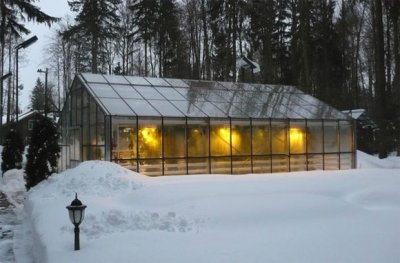
In order to grow crops all year round, it is necessary to organize heating in the greenhouse.
Special equipment allows you to maintain optimal indoor microclimate, where agricultural crops are grown.
For some of them, this is important because affects yield and growth rate.
Possible heating options in winter
Different methods of heating rooms, whether gas or air heating, have nuances that should be taken into account when choosing a heating system. for a specific greenhouse.
Gas
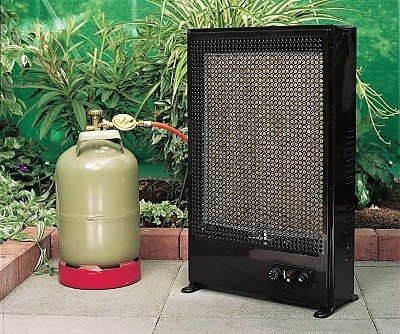
Occurs through the use of heaters, the essence of which is to burn fuel directly in the room itself. In this case, two types of burners are used: infrared and injection.
The air produced in gas devices is pre-treated mixes with external air masses.
The resulting mixture is purposefully fed into the equipped heating system. This happens both with the help of specific burners and through special hoses.
Experts recommend using a set of air-heated sources located around the perimeter of the room.
Advantages of this type of heating:
- stable supply of combustible gases;
- no need to create a special pipeline;
- the formation of carbon dioxide vapor, which is required by plants.
Along with its advantages, this type of heating also has its disadvantages:
- high cost of system operation;
- carbon dioxide oversaturation of the air;
- connection to a common pipeline if the greenhouse is quite large;
- requirement for constant ventilation of premises.
Despite the above-mentioned inconveniences of gas heating, it is still is a profitable and effective option. It is used more often in cases where the premises are small. This is due to the high cost of raw materials.
Air
The system is installed during the assembly of greenhouses by specialists with the relevant experience. To use such equipment, ventilation units. They are mounted into the foundation of the building on separate supports or load-bearing structures.
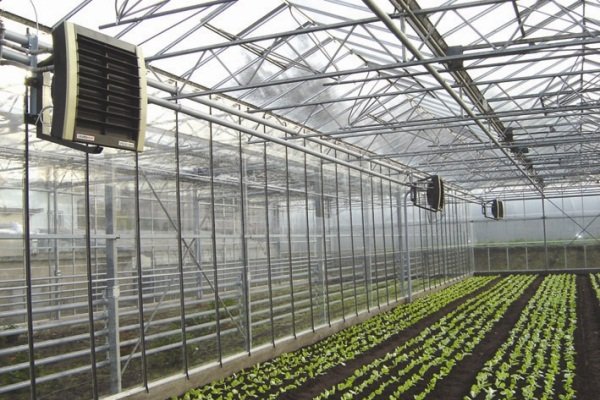
Photo 1. Air heating of the greenhouse. Devices are installed along the perimeter that maintain the optimal temperature level in the building.
Heat distribution occurs in the middle and upper parts of the greenhouse. will protect plants from burns or drying outAdditionally, a special perforated polyethylene sleeve is laid along the perimeter of the room. Heated air is evenly distributed along it.
Reference. Air heating is a popular type of heating for greenhouses. It is most often used in cases where The premises are relatively small.
Advantages of air heating of a greenhouse:
- absence of mandatory requirement to install a convector;
- uniform distribution of heat throughout the room;
- microclimate regulation;
- simplicity of technology.
Like all other systems, air heating has its disadvantages:
- the need for constant support of the heating process;
- drying of the air and the risk of burns due to improper distribution of air masses.
Using liquids: for large greenhouses
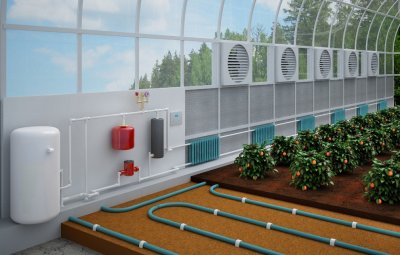
This system is essentially not much different from the usual heating of residential buildings in populated areas. Here too heated liquid is used, which moves through pipelines located in a certain configuration throughout the entire area of the room.
When organizing water heating, it is important to choose the right location for the working unit. The best option would be installing it in a separate room.
There are two types of circulation that are used when arranging a water system:
- Natural. This method is quite simple and requires the least financial costs. The heated liquid in this case moves along the pipeline to the expansion tank, after which it flows at an angle in the usual way further along the pipes.
- Artificial. This option requires the installation of a special unit, which is a circulation pump. It pushes the liquid to move throughout the system. Due to this process, there is an additional waste of electrical energy.
Water
The principle of operation is that installed boiler or The heating element heats the water in pipes, after which the liquid is directed downwards or by means of a pump begins to move through a closed system as a coolant.
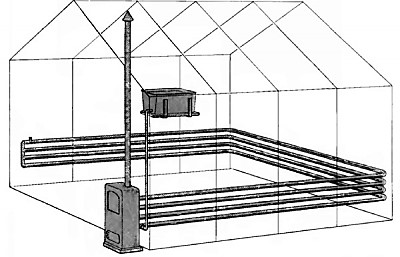
At certain points the pipelines are connected radiatorsThey ultimately become the main sources of heat radiation, as they have a significant surface area.
Water heating has the following advantages:
- high safety and reliability of use;
- no decrease in the level of humidity in the premises;
- availability of temperature control.
Main disadvantages:
- relative high cost, which arises when it is necessary to create a separate boiler room or use electrical energy;
- a certain complexity of arrangement for correct operation;
- system control.
The total cost of water heating for a greenhouse can sometimes reach impressive figures. But the equipment creates a microclimate over fairly large areas.
Electrical
Gardeners often prefer to install electric heating. For this Various types of equipment are used. First of all, there are cables, heating mats, convection units and heat pumps.
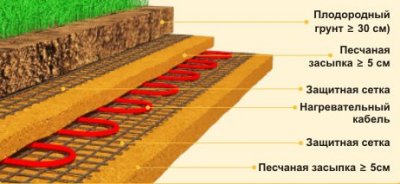
The advantages of this type of greenhouse heating are as follows:
- convenience and speed of heating;
- easy installation and mobility;
- the ability to use a thermostat for heating at night;
- fast heating and slow cooling.
The disadvantages of electric heating are quite significant:
- high cost of using the devices;
- need to connect to the network;
- dependence on electricity supply;
- air dehumidification.
Equipment that emits infrared radiation resembles natural sunlight. Objects, soil and plants absorb the waves of the devices, thereby gradually heating up. It is created optimal energy distribution.
Infrared heater
Among the electric types of heating, the most popular method at present is the use of infrared heaters. They are ceramic lamps, on one side of which there is polished steel. It helps to reflect the rays that are directed in the opposite direction from the plants.
Main advantages:
- high efficiency of application;
- ease and practicality of installation;
- if there is a thermostat, it is used at night;
- mobility.
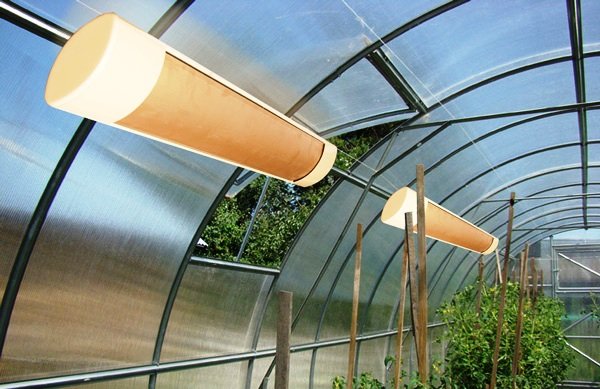
Photo 2. Infrared heaters installed in the greenhouse. They are located in the upper part of the room.
There are also some disadvantages that cannot be ignored when working with plant cultivation:
- high air dryness;
- use of an electrical source;
- relative high cost in the form of significant costs for electricity.
Reference. This type of heating is most advantageously used in cases where there are alternative sources of electricity on the site, such as, for example, solar and wind stations.
Stove
An important point is the preliminary purchase of flammable materials. Furnaces are installed based on the fuel:
- sawdust;
- peat granules;
- firewood;
- liquid and oily fuel.
Attention! It should be provided proper flue gas removal outside the premises. For this purpose, a regular pipe raised above the roof of the building is used.
The principle of operation of furnaces directly depends on the type of materials. This is due to factors such as combustion speed, amount of heat released, ease of ignition, etc. Some materials burn, while others smoulder. As a result, in one case, constant fuel addition is required, in the other, only checking the remaining volume.
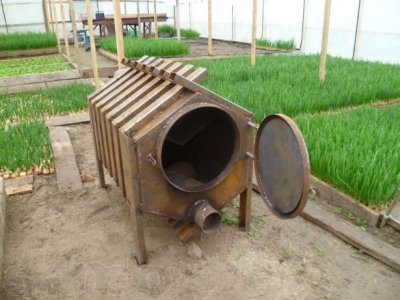
Place of loading material into the furnace is located outside the greenhouse. It is best if this is not done outside, but in a separate small room or vestibule.
This will help protect plants from soot and carbon released when wood burns.
Advantages:
- relative cheapness of the material (sawdust and firewood);
- simplicity of equipment;
- fuel availability.
If we talk about disadvantages, it is worth paying attention to the following negative aspects:
- significant financial costs when using liquid and oily materials;
- rapid loss of heat after heating is stopped;
- the need to control the reliability of the process.
Important! It is necessary to install a level and reliable foundation under the stove. It is made of concrete or bricks. The foundation is located both at ground level and deep. The distance from the walls to the ends of the greenhouse not less than 250 millimeters.
With firewood
The use of wood fuel usually involves Furnace equipment, in which it will be burned. The operating principle of such systems is simple: the combustible material heats the coolant, which gives off its energy to heat the room.
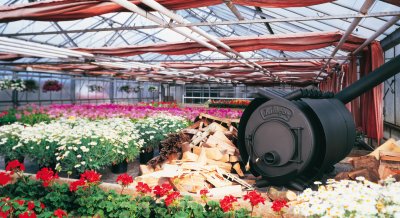
Positive qualities of using such systems:
- relative cheapness of use;
- simple construction technology;
- high efficiency;
- independent adjustment of air temperature;
- availability.
The disadvantages of using it are quite serious:
- the need for constant monitoring of the process;
- an old method of maintaining temperature conditions that has become somewhat obsolete.
If you properly equip a wood-fired stove heating system, it will still can be very effective and reliable, despite the fact that it is one of the old options for heating greenhouses.
Useful video
Watch a video that shows how to make a hydronic heating system for a greenhouse.
Choosing the right equipment will increase your yield
In order not to harm the plants grown in the greenhouse, it is important to choose a suitable system that will allow it to perform its assigned functions efficiently. To do this, first It is necessary to analyze the operating principles of all installations, their advantages and disadvantages. It is important to remember that installation must be as professional as possible, as any error will result in the work being incorrect or unreliable.







When installing a greenhouse, it is not so important which side of the world is allocated, as the open area. To increase natural lighting. The only recommendation is to place the side arches of the greenhouse facing east and west to reduce heat loss in the cool season.